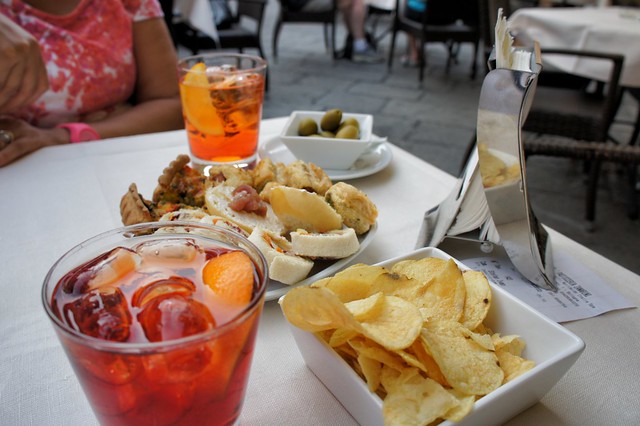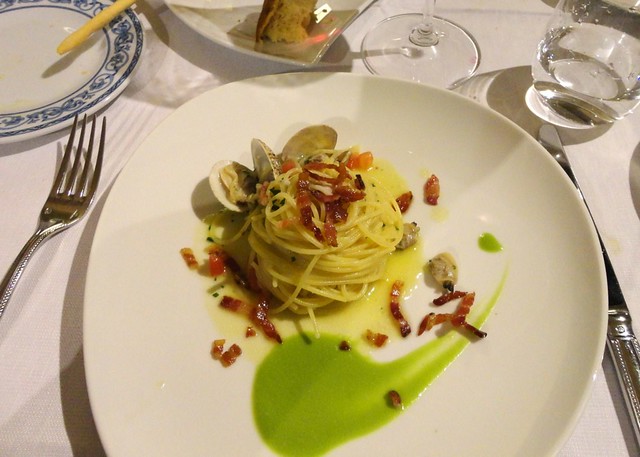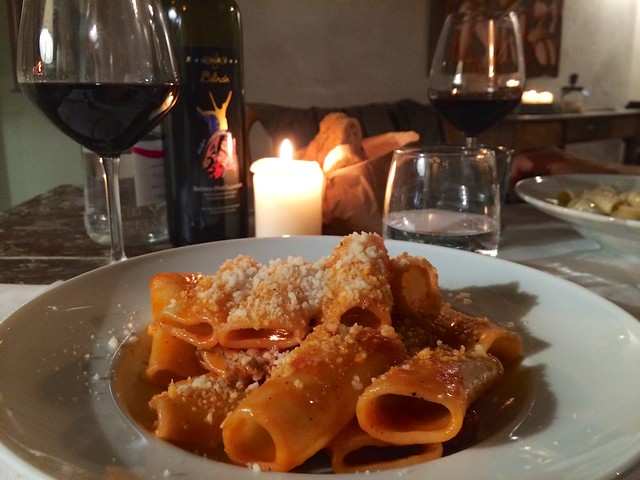Travelers to Italy often scratch their heads when presented with their restaurant bill. Though sales tax is (thankfully) included in the item prices, a number of mystery charges suddenly seem to surface when it is time to settle up. To avoid unpleasant surprises, here’s a quick overview of what these charges mean and when they apply:

(Photo by Concierge in Umbria via Flickr)
The Coperto
An Italian trattoria is like a swanky night club in that they both charge you a cover just to occupy their territory for a bit.
Not a service charge that goes to the wait staff (there is a separate “servizio” for that, below), nor the price of bread, water, or any other amenity (in case you think you can avoid the charge by refusing those items), the coperto is simply a different way of pricing menu items.
Instead of including management expenses in the listed price of individual dishes, these are listed and charged separately as the coperto.
The Coperto Costs More in Touristy Areas
If you dine (or even just stop for a coffee or cocktail) in a particularly popular part of town (the elegant Caffé Rivoire in Florence’s storied Piazza Signoria is a good example), the coperto costs more. Essentially, restaurants and cafés can charge as much as they want for coperto, as there is no legal limit, it is gauged according to what the market will bear. Some areas in Italy have banned the coperto (including Lazio, where Rome is located), but it still routinely appears on menus.

(Photo by Concierge in Umbria via Flickr)
The Coperto Must Be Listed on the Menu
You can avoid paying an exorbitant coperto (the norm is between €1 and €2 per diner) by checking the restaurant menu. Ask the host or maitre d’ for one before being seated if none is posted outside. The coperto is typically listed in tiny print either at the very top or the very bottom of the first or last menu page.
The Coperto is Charged Per Person
Imagine being unexpectedly hit with a charge of 4 euros per person for party of eight – that’s worth a whole additional meal! You may think a 4 euro coperto doesn’t sound that bad when you see it on the menu, but remember that these fees are always levied for every person at the table . . . even children.
The Servizio
Italians almost never tip at restaurants, bars, or cafés (see below), and a servizio, or “service charge” works much differently than a tip.
In theory, this is the (rare, but growing) case in which a restaurant will factor in the cost of staff expenses, though this charge doesn’t necessarily go to the staff in the same way a tip would. Also, the service charge is, unlike an optional tip, mandatory—though if it is not listed on the menu (see below), you can request the charge be taken off your bill.
The Servizio is Almost Always a Type of “Tourist Tax”
The servizio charge is almost exclusively found in the most touristed cities and areas of Italy, with one exception (see below), and most routinely applied to passing customers rather than locals or regulars. Expect to find it at restaurants along the most beaten tracks through Rome, Florence, Venice, and the Amalfi Coast, and expect to tack on an additional 10-20% to your total bill.

Photo by Concierge in Umbria via Flickr)
The Servizio Must be Listed on the Menu
Like the coperto, the servizio charge (listed as a percentage of the total bill) must be listed on the menu, and is generally in tiny print above or below the coperto charge. Though as irritating as this charge is, it is legal if listed. To avoid unpleasant nickeling and diming, check the menu before being seated.
The Servizio Exception
There is one case in which a servizio charge seems both logical and just (and is generally applied to everyone): large parties. With a party of 8-10 or more, many restaurants add an automatic service charge which is, again, stated clearly on the menu.
Tipping: The Mancia
Whatever you have heard about the proper percentage to tip in Italians restaurants, forget. That’s right. Forget it.
Italians do not tip as a percentage of their bill in restaurants. Ever.
There are a number of reasons for this cultural difference—primarily the fact that servers in Italy are paid a decent wage and do not live off tips, but also because many smaller trattorias in Italy are staffed by family—and it is a cultural difference that leaves many visiting Americans with an aftertaste of guilt.

(Photo by Concierge in Umbria via Flickr)
If You Must Leave a Mancia
If you just can’t get up from the table with a clean conscience without leaving a little something extra, you can do tipping Italian style: round up your bill to the nearest 0 or 5, or empty out your pocket change (ok, the €1 and €2 coins; the pennies may be a bit of an overkill). On the rare occasions Italians tip, this is how they do it (often circumstantially, to divide the bill evenly among a group of friends or family) and NOT as a fixed percentage of the total.
When You Probably Should Leave a Mancia
If you have gotten incredibly extraordinary service (for special dietary requirements or complicated requests) or if you have been, ahem, a bit of trouble (dining with active toddlers might fall under this category), it is kind to leave a little token of your appreciation. Again, a token.
The Mancia Paradox
Unfortunately, the cultural norm of American tipping practices have changed the cultural norm of server expectations in Italian establishments catering primarily to tourists. Though tipping isn’t expected from Italians, it has come to be expected from Americans. Every traveler to Italy should do what feels right, but tipping in a country in which it is not part of the culture often causes more harm than good in the long term.


